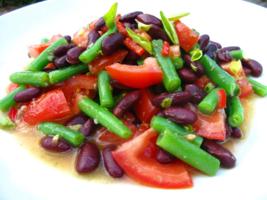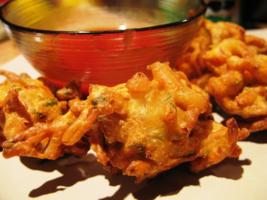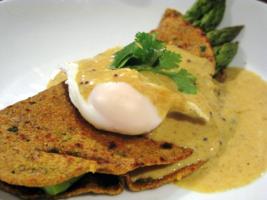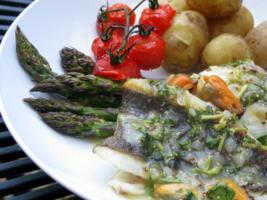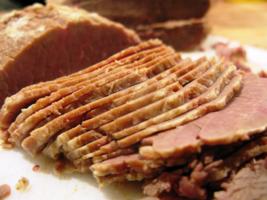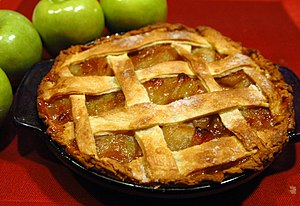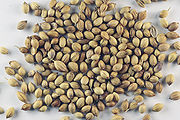Pakora are a deep fried south asian snack that were available at any Indian restaurant in Scotland when I lived there. (And I'm sure still are!) We even used to get haggis ones - they shouldn't work, but they soooooooo did! Now that I am down on the South Coast of England pakora are much more difficult to get a hold of - the closest thing you can get is onion bhaji... though I personally don't think they even comes close to pakora!
Pakora can be made from various different food stuffs - onion, spinach, chicken, fish, potato, cauliflower, mushroom etc - and is often made from a combination of two or three. The veg is bound by a gram flour spiced batter and deep fried.

I had an urge to make some last Friday night as I was staying at Boyfriend's (who has a deep fat fryer!), and chose onion, mushroom, courgette and carrot, and potato and pepper. Now I admit the last two varieties are not traditional, but I thought they might work... and they did!
Pakora keep for a few days in the fridge, and can also be frozen.
I don't weigh anything out when making things like this - so much depends on the size and wetness of the veg you use - and the spicy flavour you want from the end result. I made up the batter slightly different for each type - though each of them had garam masala and dried fenugreek leaves. Over all I think I used about 600g gram flour, 2.5 large onions, 1 large potato, 3 chillies, 1 carrot, 2 courgettes and 12 mushrooms. They made about 36 large pieces of pakora - I reckon they would have fed at least 12 people as a starter :)
Serve with a wedge of lemon to squeeze over and a simple green salad.
There are many different sauces you can get to accompany pakora. I often just buy them in from the Indian deli round the corner. However, if I don't manage that, I have two simple ones that I can knock up in minutes. (Again, I apologise to the traditionalists!)
1) Raita - mix plain yogurt with finely diced cucumber (remove the seeds), a handful of mint and a squeeze of lemon juice for a cooling dip.
2) Mix tomato ketchup with lemon juice, tabasco sauce and dried red chile flakes for a hotter sauce to dip into.
Before you start, preheat your deep fryer to 175 degrees celcius.
Onion Pakora
2 large onion, halved and thinly sliced
gram (chickpea) flour
water to mix (not too much!)
garam masala
dried fenugreek leaves
ground cumin and coriander
small handful roughly chopped coriander
dried red chile flaked to taste
1/2 tspn baking powder
salt
Place onions in a large mixing bowl.
Sprinkle over 2 large handfuls of gram flour, the baking powder, a good pinch of fenugreek leaves, all the spices you want to use. Give it a good stir, them add a bit of water to make a fairly thick paste. You want the batter to be thick enough to cling to the onion, but not so thick that it clumps together too much (otherwise it will go stodgey in the middle). And if it's too thin the pakora won't stick together in the fat, and will separate into pieces... You might want to add another bit of flour, then another bit of water if you want more batter.

Make sure you salt the batter at this stage - as you can't really add it afterwards. To check the seasoning you'd have to deep fry a little bit of the batter for a minute or so and taste. I probably added a teaspoon.
Carefully drop spoonfuls of the mixture into the hot oil, and cook for about 6 minutes. They can be kept warm in the oven til ready to eat.

Mushroom Pakora
This time, start off by mixing the gram flour with a bit of water to mix to a thick batter, then add the baking powder, spices, fenugreek and salt. I kept my mixture quite similar this time - but added more dried red chillies for a bit of extra heat. Remember, there is much more veg to batter in this one, so you can flavour it more strongly.
Add the mushrooms and stir to thouroughly coat.
Drop the mushrooms into the hot oil, and again, cook for about 6 minutes.
Courgette and Carrot Pakora
Mmmmm - I absolutely loved these - they were gorgeous and moist in the middle, with a proper crunch on the outside!
Grate the courgette, place in a sieve and sprinkle with salt to draw out the excess juices. Squeeze them dry and place into a bowl with the grated carrot. As before add gram flour and water until you have a thick batter. Add the fenugreek, spices, baking powder, and a handful of chopped coriander. For this one I omitted the dried red chile, but added one scotch bonnet chile pepper, finely chopped. I even left the seeds in as I wanted some heat! ;)
Cook as before.
Onion and Red Pepper Pakora
Chop a large potato into 1cm dice, and par boil for 3 minutes until slightly softened. Thinly slice half an onion and add to the drained potatos. Finely dice a red pepper and add to the other veg.
I then added 2 thai red chiles - finely chopped, a large handful of coriander, and one crushed clove of garlic.
For spices, I added garam masala, fenugreek leaves, tumeric, cumin and coriander.
Mix all the above with gram flour and baking powder to form a thick batter - adding water as required.
Deep fry as above.



